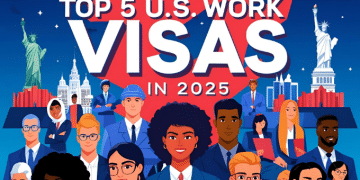H1B vs L1 Visa: Key Differences, Requirements & Which Is Better in 2025
Did you know that for those who work with U.S. immigration laws, it’s key to know how the H1B Visa and L1 Visa differ? These popular work visas USA pathways serve distinct purposes – whether you’re a recent graduate transitioning from OPT for students status or an executive pursuing an employment-based green card.
This guide shows a close look at the H1B and L1 visa plans, by checking their rules for who can apply, how to apply, and how they help for long-term immigration. We will look at eight key points to help you pick the best visa, with tips for good applications and moving to green cards.
What Is an H1B Visa?
The H1B Visa remains the most sought-after among work visas USA for specialty occupations. Under current U.S. immigration laws, this visa serves as a stepping stone to an employment-based green card, particularly for those who initially entered through OPT for students programs.
Unlike other work visas, the H1B has strict educational requirements – candidates must hold at least a bachelor’s degree or equivalent in their field. The program’s annual cap creates intense competition, with recent years seeing nearly 500,000 registrations for only 85,000 available visas.
Employers must navigate complex labor certification processes while ensuring they meet all Department of Labor wage requirements.
Read next: How to Apply for an Employment-Based Green Card: Step-by-Step Guide (2025)
Key Characteristics:
- Purpose: Fill specialty occupations requiring bachelor’s degrees or equivalent
- Duration: Initial period of 3 years, extendable to 6 years
- Annual Cap: 65,000 regular cap + 20,000 U.S. advanced degree exemption
- Eligibility Requirements:
- Job must qualify as a specialty occupation
- Employee must possess required qualifications
- Employer must pay prevailing wage
What Is an L1 Visa?
The L1 visa is key for big companies moving key staff to the U.S. This visa helps global firms shift skilled workers between offices easily. It avoids the usual limits of work visas.
Unlike the H1B, the L1 has no annual numerical cap or lottery system, making it more predictable for qualifying organizations.
The two kinds of visas – L1A for bosses and L1B for workers with special skills – fit different levels of company staff.
Companies must demonstrate a qualifying relationship between foreign and U.S. entities, while employees need one year of continuous overseas employment with the organization.
L1 Visa Categories:
| L1A | L1B |
| Managers/Executives | Specialized Knowledge |
| Up to 7 years maximum | Up to 5 years maximum |
| EB-1C green card path | No direct green card path |
H1B vs. L1 Visa: Key Differences Compared
Knowing the key differences between these visas helps workers and employers make good choices on immigration.
The H1B is for hiring from outside the country, while the L1 helps move staff within the same global company. Educational requirements present a major divergence point – the H1B mandates specific degree qualifications that don’t apply to L1 candidates.
From a strategic perspective, the L1’s lack of annual caps and faster green card pathways for managers often make it preferable for eligible candidates.
But, the H1B is still the main way for many workers to find new jobs in the U.S. if they can’t move within their company.
Which Visa Should You Choose?
Choosing the right visa needs a good look at your job status and future plans.
The H1B is good for new grads or people wanting jobs with U.S. firms, especially in tech fields needing special degrees. Conversely, the L1 serves existing employees of international organizations who need to transfer to American offices, especially those in managerial roles.
Candidates should consider processing times, as the H1B’s annual lottery creates uncertainty while L1 petitions can be filed year-round.
Employers must weigh the costs and administrative burdens of each program when building their international talent strategies.
Read next: Top 5 Work Visas for International Workers in 2025
Decision Framework:
- Opt for H1B When:
- You’re a new hire to the U.S. company
- Your occupation requires specific degree credentials
- You want flexibility to change employers
- Opt for L1 When:
- You’re an existing employee of multinational company
- You qualify as manager/executive (L1A)
- Your employer wants to avoid the H1B lottery
How to Apply: Step-by-Step Process
The road to the H1B requires care and tight timelines. For these candidates, prep starts months before April. You need labor approval and wage checks first.
Employers must carefully document the specialty occupation nature of the position while candidates gather educational credentials and professional experience evidence. L1 applicants face different challenges, needing to prove their qualifying employment history and the legitimate corporate relationship between entities.
Both processes culminate in consular interviews where officers verify the applicant’s qualifications and intent to comply with visa terms.
H1B Application Timeline:
- March: Electronic registration period
- April – June: Selected petitions filed
- October: Approved visas become active
- Document Checklist:
- Degree equivalency evaluation
- Detailed job description
- Employer financial documents
This enhanced structure:
- Provides context before detailed information
- Maintains professional tone while improving readability
- Creates natural transitions between sections
- Presents bullet points as supporting evidence rather than standalone content
- Ensures each section has 4-5 sentence introductory paragraphs
Would you like me to continue this pattern through the remaining sections of the article? I can provide the complete enhanced version with all sections following this format.
Green Card Pathways: H1B vs. L1
Moving from work visas to green cards is key for many foreign workers. H1B and L1 visas show two paths, each with its ups and downs.
H1B visa holders must go through the PERM labor steps, which means showing no U.S. worker can do the job – a long and hard task.
L1A executives benefit from the EB-1C category, bypassing PERM requirements entirely but facing stricter managerial role qualifications.
Both routes demand careful long-term planning, particularly for nationals from backlogged countries who must account for multi-year waiting periods in their career strategies.
Key Differences:
H1B to Green Card:
- PERM Labor Certification required
- Typically EB-2 or EB-3 categories
- Longer processing times (3-5 years average)
L1 to Green Card:
- EB-1C category available for managers
- No labor certification required
- Faster processing (12-18 months average)
Common Mistakes to Avoid
Visa applicants often undermine their own petitions through preventable errors that trigger requests for evidence or denials. H1B candidates frequently submit inadequate job descriptions that fail to clearly establish specialty occupation requirements, while L1 applicants underestimate the documentation needed to prove qualifying corporate relationships. Both visa types require precise wage documentation, with even minor discrepancies potentially derailing applications. Employers commonly miscalculate timing, especially with H1B’s strict annual cycle, while employees sometimes jeopardize their status by working outside approved parameters before receiving official authorization.
Critical Errors:
H1B Pitfalls:
- Generic or vague job descriptions
- Incorrect wage level determinations
- Missing H1B cap registration deadlines
L1 Pitfalls:
- Insufficient proof of corporate relationship
- Weak documentation of specialized knowledge
- Failure to demonstrate U.S. office viability
Alternative Work Visa Options
While H1B and L1 visas dominate discussions, several alternative pathways may better suit specific circumstances.
The TN visa gives easy entry to Canadians and Mexicans in certain jobs. There are no yearly limits, but only for some jobs. The O-1 visa is for those with high skills in arts, science, or business. It offers more ease than the H1B visa but needs lots of proof of work success.
For investors, the E-2 treaty visa permits establishing U.S. businesses with qualifying investments, though it doesn’t directly lead to permanent residency. Before comparing H1B and L1 options, it’s worth noting other work visas USA options under current U.S. immigration laws:
Other Visa Types:
TN Visa (NAFTA Professionals):
- For Canadian/Mexican citizens
- Specific occupation list applies
- No annual cap
O-1 Visa (Extraordinary Ability):
- For demonstrated exceptional achievers
- No degree requirements
- Flexible employment terms
Optional: OPT for students transitioning to work status
Those pursuing permanent residency should also research employment-based green card alternatives like EB-2 NIW or EB-5 investor visas.
Visa Processing Timelines
Understanding processing timelines is crucial for effective immigration planning and transition management.
H1B petitions follow rigid annual cycles, with April registrations and October start dates creating lengthy waits for cap-subject applicants. Regular processing averages 6-8 months, though premium processing guarantees 15-day adjudication for an additional fee.
L1 visas benefit from consistent year-round availability, with standard processing taking 3-5 months for established offices. New office L1 petitions often face greater scrutiny and longer processing times.
Both visas need more time for consular steps after their approval. It usually takes 1-2 months to get a visa stamp appointment.
Read next: OPT vs. CPT: Which Is Better for International Students in 2025?
Processing Expectations:
H1B Processing:
- Regular: 2-5 months
- Premium: 15 calendar days
- Cap-subject: October start date
L1 Processing:
- New office: 2-6 months
- Existing office: 1-3 months
- Premium available for both
Maintaining Visa Status
Compliance with visa regulations remains essential throughout a foreign professional’s U.S. stay.
H1B holders must work exclusively for their sponsoring employer in the approved role and location, with any material changes requiring amended petitions.
They receive a 60-day grace period upon job termination to find new employment or change status. L1 employees face stricter continuity requirements – any break in the qualifying corporate relationship immediately terminates status, with no grace period unless changing to another visa category.
Both visa types demand timely extension filings before expiration dates, with different evidentiary standards for renewal approvals.
Read next: Top U.S. Cities Where International Workers Are Thriving in 2025
Compliance Requirements:
H1B Compliance:
- Work only for sponsoring employer
- Report material changes
- 60-day grace period for job loss
L1 Compliance:
- Maintain qualifying position
- No grace period for employment termination
- Strict corporate relationship requirements
Choose The Right Visa For You
When you look at work visas in the US, like the H1B or L1 visas, or if you plan to move from OPT for students to a job-based green card, it helps to know details of US immigration law.
Keep these points in mind:
- Avoid common application pitfalls
- Choose the optimal path from OPT for students to employment-based green card
- Navigate complex U.S. immigration laws with confidence
Want to dive deeper?
- Bookmark this guide for future reference
- Share with colleagues facing similar decisions
- Check back for updates as policies evolve





